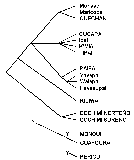Aboriginal Languages
 For contemporary Native Americans, Baja California’s aboriginal languages are an important part of their cultural heritage. Professional linguists study these languages to seek clues to the universality or diversity of various features and processes in human speech. Anthropologists discover in them traces of prehistoric migrations and patterns of cultural change and interaction, both within the peninsula and across wider reaches of western North America.
For contemporary Native Americans, Baja California’s aboriginal languages are an important part of their cultural heritage. Professional linguists study these languages to seek clues to the universality or diversity of various features and processes in human speech. Anthropologists discover in them traces of prehistoric migrations and patterns of cultural change and interaction, both within the peninsula and across wider reaches of western North America.
Many of the native people in northernmost Baja California still speak their ancestral tongues, and in recent years a number of linguists, including James M. Crawford, Leanne Hinton, Judith Joël, Mauricio J. Mixco, and Jesús Angel Ochoa Zazueta, have been active in documenting and analyzing them. South of San Quintín, the aboriginal languages became extinct during the 18th and 19th centuries. For knowledge of the southern languages, we are entirely dependent upon the records written by early visitors, particularly Jesuit missionaries such as Jakob Baegert, Miguel del Barco, and Franz Benno Ducrue. Because of gaps in information, scholars disagree as to the number of distinct languages in the peninsula and their geographical ranges.
The northernmost aboriginal Baja Californians spoke languages belonging to the Yuman family, including Kiliwa, Paipai, Tipai, Kumeyaay (Kumiai in Spanish), Cocopa (Cucapá), and Quechan. Using the controversial technique of glottochronology, it has been estimated that the initial separation of the Yuman family into different languages occurred perhaps 2,500 years ago. Suggested homelands for the original Yumans were on the lower Colorado River or in northwestern Baja California. Cocopa, Kumeyaay, and Tipai, along with Ipai in Alta California, are very closely related to each other, separated by perhaps about 1,000 years of independent development. Quechan is related to Mohave and Maricopa, on the Colorado and Gila rivers. Surprisingly from a geographic point of view, Paipai’s nearest links are to the language of the western Arizona Yumans, the Yavapai, Walapai, and Havasupai. Kiliwa stands alone as the most divergent of the languages within the Yuman family.
 A slightly more remote connection joined the Yuman family with Cochimí, the language or group of languages spoken throughout the central half of Baja California, from north of El Rosario to the vicinity of Loreto in the south. (Cochimí of central Baja California should not be confused with the Tipai dialect at La Huerta which is sometimes also known by that name.)
A slightly more remote connection joined the Yuman family with Cochimí, the language or group of languages spoken throughout the central half of Baja California, from north of El Rosario to the vicinity of Loreto in the south. (Cochimí of central Baja California should not be confused with the Tipai dialect at La Huerta which is sometimes also known by that name.)
Much more distant relationships, probably dating back in excess of 5,000 years, existed between Yuman-Cochimí and several other families belonging to the Hokan linguistic phylum. Hokan languages were scattered around the periphery of Alta California, including Chumash, Pomo, Washo, and others; the Seri hunter-gatherers of the Sonoran coast across the Sea of Cortés are apparently also Hokan speakers. Within Baja California, south of the Cochimí, the Monqui of Loreto and the Guaycura of the Magdalena Plains may have belonged to the Hokan phylum. In the extreme south of the Cape Region, Pericú is an linguistic enigma. It may have been related to Guaycura, or it may not; the evidence is too meager to say.
For additional discussions of the distributions and relationships of Baja California languages, refer to the Bibliography, and to such sources as Gursky 1966; Joël 1998; Laylander 1993, 1997a; León-Portilla 1976; Massey 1949; Mathes 1975a, 1977a; Mixco 1977d, 1978; Ochoa Zazueta 1979, 1982b; and Robles Uribe 1965.
© 2002 Don Laylander